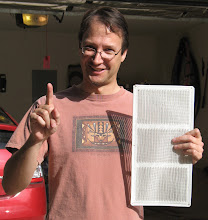As most readers of this blog probably already know, traditional insulation is only a part of reducing heat flow into and out of a house's living area, and should be looked in concert with other means of blocking heat flow such as radiant barriers, and cooling mechanisms like attic ventilation.
Nevertheless, insulation is an important warrior in the heat flow reduction battle whose role should not be taken lightly. In fact, good insulation greatly reduces heat flow from the mechanisms of both conduction and convection, and perhaps even a small extent by radiation as well.
The heat flow reduction properties of insulation are quantified by its "R-value", with higher R-values being more able to reduce heat flow. There's a good layman's description (with full equations and a nifty table of materials) here on wikipedia.
The recommended total R-value for my home's attic when it was built in 1996 was R-30. In terms of my fiberglass blown-in insulation which has an R-value of about 2.5 per inch of thickness, that would mean I should have had 30 / 2.5 = 12 inches of insulation. That actually would have covered up most of the wooden joists on the floor of the attic, but in fact, it did not. The depth of insulation varied, of course, but my best guess as to the average depth was about 9 inches, yielding an actual R-value of 9 x 2.5 = R-22.
So not only was my insulation insufficient for the building codes in 1996, it was now 2009, and we as a society have realized (to some small extent) that we're underinsulating our buildings. The new code seems to be R-49 for my area, which would equate to 49 / 2.5 = about 20 inches of insulation.
So I needed at least 20 inches of insulation, but I had less than half that. What would I do about this discrepancy? And would it keep me from finishing my radiant barrier for yet another summer?
Next: Find out!
Wednesday, October 21, 2009
Subscribe to:
Post Comments (Atom)


No comments:
Post a Comment